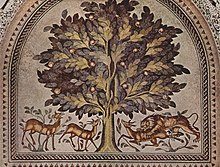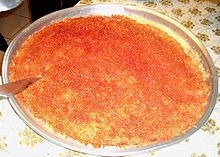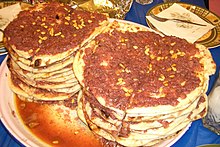User:Slowking4/Culture of Palestine
The Culture of Palestine is closely related to those of the nearby Levantine countries such as Lebanon, Syria, and Jordan, and the Arab World. Cultural contributions to the fields of art, literature, music, costume and cuisine express the Palestinian experience despite the geographical separation between Palestinian territories, Israel and the diaspora.[1][2][3]
Al-Quds Capital of Arab Culture is an initiative undertaken by UNESCO under the Cultural Capitals Program to promote Arab culture and encourage cooperation in the Arab region. The opening event was launched in March 2009.
Sports
[edit]The Palestinian Oympic committee is working with the Israeli Olympic committee to train for the 2012 Olympic games,[4] and participation in the 2013 Mediterranean Games.[5]
There is a West Bank Premier League, and Gaza Strip League. The Palestine national football team played Afghanistan in the 2014 FIFA World Cup qualifiers.
The Beit Jala Lions is a West Bank Rugby Union team.
The Turmus Aya Equestrian Club, established in 2007, is a riding club dedicated to the mission of providing affordable access to horses for Palestinians. Ashraf Rabi, the founder, maintains that "this is part of the development of Palestine. Horses are a big part of our Arab culture and we must embrace it." [6]
Art
[edit]
Similar to the structure of Palestinian society, the Palestinian field of arts extends over four main geographic centers:[7] 1) the West Bank and Gaza Strip 2) Israel 3) the Palestinian diaspora in the Arab world, and 4) the Palestinian diaspora in Europe, the United States and elsewhere.
Contemporary Palestinian art finds its roots in folk art and traditional Christian and Islamic painting. After the 1948 Palestinian exodus, nationalistic themes have predominated as Palestinian artists use diverse media to express and explore their connection to identity and land.[8] In the 1990s Salam Dyab, Hisham Zreiq, Issa Dibe and others began to adopt modern styles and symbolism.
Cuisine
[edit]


Palestine's history of rule by many different empires is reflected in Palestinian cuisine, which has benefited from various cultural contributions and exchanges. Generally-speaking, modern Syrian-Palestinian dishes have been influenced by the rule of three major Islamic groups: the Arabs, the Persian-influenced Arabs and the Turks.[9] The Arabs who conquered Syria and Palestine had simple culinary traditions primarily based on the use of rice, lamb and yogurt, as well as dates.[10]
The cuisine of the Ottoman Empire — which incorporated Palestine as one of its provinces in 1512-14 — was partially made up of what had become, by then a "rich" Arab cuisine. After the Crimean War, in 1855, many other communities including Bosnians, Greeks, French and Italians began settling in the area especially in Jerusalem, Jaffa and Bethlehem. The cuisine of these communities, particularly those of the Balkans, contributed to the character of Palestinian cuisine.[9][11] Nonetheless, until around the 1950s-60s, the staple diet for many rural Palestinian families revolved around olive oil, oregano (za'atar) and bread, baked in a simple oven called a taboon.[12]
There are several foods native to Palestine that are well-known in the Arab world, such as, kinafe Nabulsi, Nabulsi cheese (cheese of Nablus), Ackawi cheese (cheese of Acre) and musakhan. Kinafe originated in Nablus, as well as the sweetened Nabulsi cheese used to fill it. Baqlawa, a pastry introduced at the time of the Ottoman Sultan Suleiman the Magnificent, is also an integral part of Palestinian cuisine.[13]
Chick-pea based falafel, which substituted for the fava beans used in the original Egyptian recipe and added Indian peppers introduced after the Mongol invasions opened new trade routes, are a favorite staple in Mediterranean cuisine, since adopted as part of Israeli cuisine.[14]
Entrées that are eaten throughout the Palestinian Territories, include waraq al-'inib — boiled grape leaves wrapped around cooked rice and ground lamb. Mahashi is an assortment of stuffed vegetables such as, zucchinis, potatoes, cabbage and in Gaza, chard.
Film
[edit]Palestinian cinema is relatively young compared to Arab cinema overall and many Palestinian movies are made with European and Israeli support.[15] Palestinian films are not exclusively produced in Arabic; some are made in English, French or Hebrew.[16] More than 800 films have been produced about Palestinians, the Israeli-Palestinian conflict, and other related topics, examples include Divine Intervention and Paradise Now.
Handicrafts
[edit]A wide variety of handicrafts, many of which have been produced by Palestinians for hundreds of years, continue to be produced today. Palestinian handicrafts include embroidery and weaving, pottery-making, soap-making, glass-making, and olive-wood and Mother of Pearl carvings, among others.[17][18]
Intellectuals
[edit]In the late 19th century and early 20th century, Palestinian intellectuals were integral parts of wider Arab intellectual circles, as represented by individuals such as May Ziade and Khalil Beidas. Educational levels among Palestinians have traditionally been high. In the 1960s the West Bank had a higher percentage of its adolescent population enrolled in high school education than did Lebanon.[19] Claude Cheysson, France’s Minister for Foreign Affairs under the first Mitterrand Presidency, held in the mid eighties that, ‘even thirty years ago, (Palestinians) probably already had the largest educated elite of all the Arab peoples.’[20]
Diaspora figures like Edward Said and Ghada Karmi, Arab citizens of Israel like Emile Habibi, and Jordanians like Ibrahim Nasrallah[21] have made contributions to a wide number of fields, exemplifying the diversity of experience and thought among Palestinians.[22]
Literature
[edit]The long history of the Arabic language and its rich written and oral tradition form part of the Palestinian literary tradition as it has developed over the course of the 20th and 21st centuries.
Poetry
[edit]Poetry, using classical pre-Islamic forms, remains an extremely popular art form, often attracting Palestinian audiences in the thousands. Until 20 years ago, local folk bards reciting traditional verses were a feature of every Palestinian town.[23] After the 1948 Palestinian exodus, poetry was transformed into a vehicle for political activism. From among those Palestinians who became Arab citizens of Israel after the passage of the Citizenship Law in 1952, a school of resistance poetry was born that included poets like Mahmoud Darwish, Samih al-Qasim, and Tawfiq Zayyad.[23] The work of these poets was largely unknown to the wider Arab world for years because of the lack of diplomatic relations between Israel and Arab governments. The situation changed after Ghassan Kanafani, another Palestinian writer in exile in Lebanon, published an anthology of their work in 1966.[23] Palestinian poets often write about a sense of loss and the diaspora.[23]
Music
[edit]
Palestinian music is well-known and respected throughout the Arab world.[25] A new wave of performers emerged with distinctively Palestinian themes following the 1948 Palestinian exodus, relating to the dreams of statehood and the burgeoning nationalist sentiments. In addition to zajal and ataaba, traditional Palestinian songs include: Bein Al-dawai, Al-Rozana, Zarif - Al-Toul, and Al-Maijana, Dal'ona, Sahja/Saamir, Zaghareet. For over three decades, the Palestinian National Music and Dance Troupe (El Funoun) in Palestine[26] has promoted and developed Palestinian traditional songs and dance. Examples include Mish'al (1986), Marj Ibn 'Amer(1989) and Zaghareed (1997) a collection of Palestinian traditional wedding songs reinterpreted and re-arranged by Mohsen Subhi. (See section on "External links"). The Ataaba is a form of folk singing that spread outwards from Palestine. It consists of 4 verses, following a specific form and meter. The main aspect of the ataaba is that the first three verses must end with the same word meaning three different things, and the fourth verse comes as a conclusion to the whole thing. It is usually followed by a dalouna.
- ^ Ismail Elmokadem (10 December 2005). "Book records Palestinian art history". Retrieved 2008-04-18.
- ^ Danny Moran. "Manchester Festival of Palestinian Literature". Manchester Festival of Palestinian literature. Archived from the original on March 31, 2008. Retrieved 2008-04-18.
- ^ Regev Motti (1993), Oud and Guitar: The Musical Culture of the Arabs in Israel (Institute for Israeli Arab Studies, Beit Berl), ISBN 965-454-002-9, p. 4.
- ^ http://sports.espn.go.com/oly/news/story?id=6395079
- ^ http://www.sportsfeatures.com/olympicsnews/story/48500/rome-hosts-israel-and-palestine-to-promote-peace-through-sport
- ^ Equestrian club caters to all
- ^ Tal Ben Zvi (2006). "Hagar: Contemporary Palestinian Art" (PDF). Hagar Association. Retrieved 2007-06-05.
- ^ Ankori, 1996.
- ^ a b Revisiting our table... Nasser, Christiane Dabdoub, This week in Palestine, Turbo Computers & Software Co. Ltd. June 2006. Retrieved 2008-01-08.
- ^ ABC of Arabic Cuisine ArabNet. Retrieved 2007-12-25.
- ^ An Introduction to Palestinian Cuisine: Typical Palestinian Dishes This Week in Palestine, Turbo Computers & Software Co. Ltd. July 2001. Retrieved 2007-01-07.
- ^ Modernity and Authenticity: The Evolution of the Palestinian Kitchen Qleibo, Ali, This week in Palestine, Turbo Computers & Software Co. Ltd. December 2006. Retrieved 2008-01-09.
- ^ nigelparry.net. "Joseph Massad, 'Munich, or Making Baklava,' ''The Electronic Intifada'', 3 February 2006". Electronicintifada.net. Retrieved 2009-04-22.
- ^ VJJE Publishing Co. "Jodi Kantor, 'A History of the Mideast in the Humble Chickpea.'". E-cookbooks.net. Retrieved 2009-04-22.
- ^ "Xan Brooks on Palestinian directors | Film | The Guardian". London: Film.guardian.co.uk. 2006-04-12. Retrieved 2009-04-22.
- ^ [1][dead link]
- ^ Jacobs et al., 1998, p. 72.
- ^ Karmi,2005, p. 18.
- ^ West Bank 44.6% versus 22.8% in Lebanon. See Elias H.Tuma, Haim Darin-Drabkin, The Economic case for Palestine, Croom Helm, London, 1978 p.48.
- ^ Interview with Elias Sanbar. Claude Cheysson, ‘The Right to Self-Determiniation,’ Journal of Palestine Studies Vol.16, no.1 (Autumn 1986) pp.3-12 p.3
- ^ Jordanian Poets: Samer Raimouny, Mustafa Wahbi, Haider Mahmoud, Ibrahim Nasrallah
- ^ "Biography Ibrahim Nasrallah". Pontas literary & film agency. Retrieved 14 December 2010.
- ^ a b c d Shahin, 2005, p. 41.
- ^ William McClure Thomson, (1860): The Land and the Book: Or, Biblical Illustrations Drawn from the Manners and Customs, the Scenes and Scenery, of the Holy Land Vol II, p. 578.
- ^ Christian Poche. "Palestininan music". Grove Dictionary of Music and Musicians. Retrieved 2008-03-10.[dead link]
- ^ http://www.el-funoun.org/productions/zaghared.html
